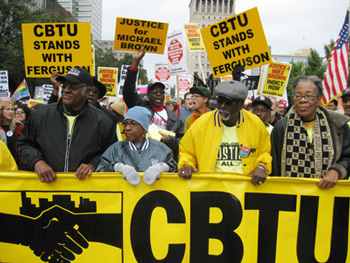

Vol. 78/No. 38 October 27, 2014

|
| Militant/Dan Fein |
| Just days before weekend protests in Missouri to demand arrest of officer who killed Michael Brown in Ferguson, cop shot Vonderrit Myers Jr. in nearby St. Louis. Above, contingent of Coalition of Black Trade Unionists at Oct. 11 march in St. Louis against killings by cops. |
On Oct. 8 a cop here killed 18-year-old Vonderrit Myers Jr. He was struck by seven of the 17 bullets fired at him by a yet unnamed St. Louis police officer moonlighting for a private security firm.
Myers’ killing sparked an immediate response from residents in Shaw, the predominantly Black community where he lived.
In addition to Black rights organizations, church groups and youth groups, contingents joined the march from the United Food and Commercial Workers, Communications Workers of America, Chicago Teachers Union, Service Employees International Union, Nurses United, United Electrical Workers, UNITE HERE, Coalition of Black Trade Unionists and A. Philip Randolph Institute. The largest labor group was fast-food workers organizing for $15 an hour and a union. The action was promoted by an ad by Richard Trumka, president of the AFL-CIO.
“We brought two buses from Chicago, that’s how important we think this is,” Damien Mack, a 22-year-old African-American worker at McDonald’s in Chicago, told the Militant. “If we bring the fight against police brutality together with the fight for $15 and a union it will help make both more effective.”
While African-Americans made up more than half of the demonstrators, they were joined by large numbers of Caucasians, Asians and Latinos.
“Both immigrants and Blacks are targeted by local law enforcement,” Maru Mora of Latino Advocacy in Seattle said. She was marching with a group opposing deportation of workers and youth without papers.
“I live in Ferguson, I saw what was going on and wanted to get involved, both to express my outrage at what happened to Mike Brown and to help the young people organize peaceful, legal protests,” said John Caradine, a member of SEIU Local 1 at St. Louis-area plastics manufacturer Contico. “So I raised it with the officials of our union, others were doing the same thing. They heard us and decided to act on it.”
“In Chicago we’re fighting the same thing,” said Katie Osgood, an elementary school teacher who is Caucasian and works on Chicago’s South Side, an overwhelmingly African-American area. She was marching with fellow members of the Chicago Teachers Union. “We’re fighting for the kind of world where my students’ parents don’t have to worry about their kid not coming home alive from school because they are people of color. That’s why we’re here.”
“It’s important for organized labor to support the Black community’s call for justice for Mike Brown,” Lou Moye, president of the St. Louis Coalition of Black Trade Unionists, said. “My group sponsored the march for the same reason we joined coal miners campaigning against Peabody’s attack on union pensions a year ago — solidarity.”
Ashley Yates of Millenial Activists United and St. Louis rapper Tef Poe of the Organization for Black Struggle and Hands Up United co-chaired the Kiener Plaza rally. “A new generation is standing up and saying no matter what you do we will not bow down!” Rev. Osagyefo Sekou of the Fellowship of Reconciliation told the crowd.
Organizers of the FergusonOctober weekend included Organization for Black Struggle, Missourians Organizing for Reform and Empowerment, Hands Up United, CWA, American Federation of Government Employees Local 3354, Korean American Resource and Cultural Center, United for Peace and Justice and Missouri/Kansas State Council SEIU.
Later Saturday evening about 400 people marched from Canfield Drive, where the memorial marking the spot where Brown was killed still stands, to the Ferguson police headquarters, led by his mother Lesley McFadden.
Some 1,000 protesters attended an interfaith church service at St. Louis University Sunday night. Later hundreds more marched from the spot where Myers was killed in the Shaw neighborhood to the university, where they staged a sit-in overnight.
The national actions took place against the backdrop of continuing local protests, including an Oct. 5 action in Ferguson pressing for the arrest of Wilson, led by Brown’s father Michael Brown Sr.
Protesters and defenders of democratic rights won an important victory Oct. 6 when U.S. District Judge Catherine Perry overturned a Ferguson cop decision to force demonstrators standing on city sidewalks to move every five seconds or face arrest. Police began charging protesters Aug. 18 along West Florissant Avenue in an effort to dampen protests following the killing of Brown.
Front page (for this issue) |
Home |
Text-version home